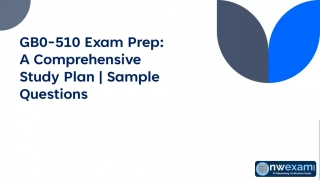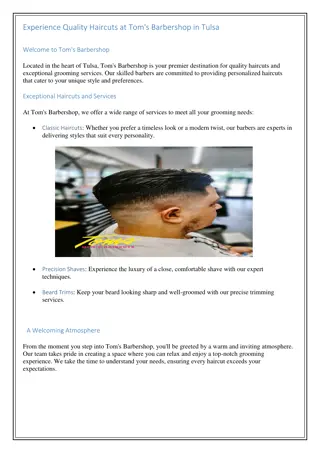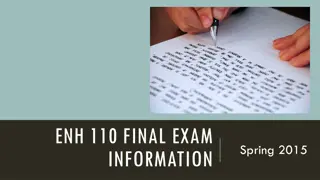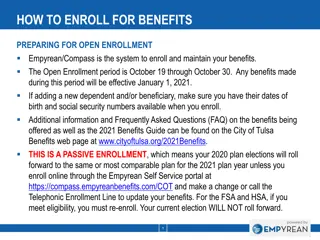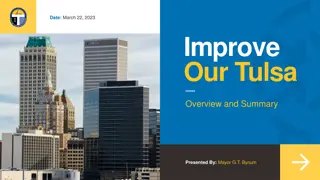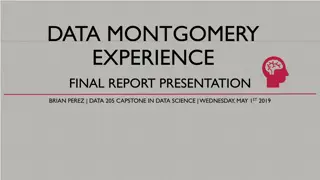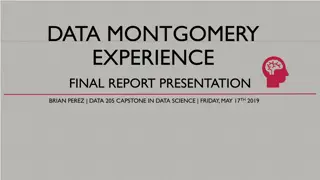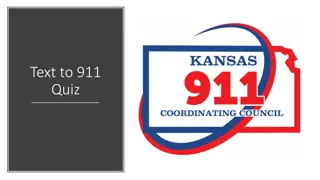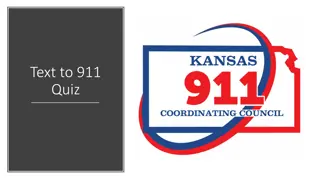
Optimizing 911 Communication Center Staffing Analysis
Explore the correlation between 911 call volume, weather patterns, and staffing levels in a comprehensive analysis of data from Tulsa's emergency communication center. Discover key insights and trends to enhance emergency response efficiency.
Download Presentation

Please find below an Image/Link to download the presentation.
The content on the website is provided AS IS for your information and personal use only. It may not be sold, licensed, or shared on other websites without obtaining consent from the author. If you encounter any issues during the download, it is possible that the publisher has removed the file from their server.
You are allowed to download the files provided on this website for personal or commercial use, subject to the condition that they are used lawfully. All files are the property of their respective owners.
The content on the website is provided AS IS for your information and personal use only. It may not be sold, licensed, or shared on other websites without obtaining consent from the author.
E N D
Presentation Transcript
Optimizing 911 Communication Center Staffing: Part 2 July 25, 2019
Tackling the Problem Phase 1 Phase 2 The Side Project Use 2 years of phone data to chart hourly call numbers for all calls into Tulsa Police queue. Determine if there is a pattern for day of the week and hour of the day as well as what months of the year have the highest call volume. Use data for police calls to determine the average call handling time for each police incident from call pickup to assignment to dispatch. Determine if there is correlation between call handling time and staffing level. Use call volume data from the emergency communication center and advisory, watch, and warning data from the National Weather Center to determine if there is a correlation between weather patterns and 911 call volume.
Guiding Questions Question 1: Can we combine ECATS and CAD to confirm call pickup and duration times? Question 2: Relationship between weather and call volume?
What did we learn from last time? Source: TulStat 911 Public Safety Communications Presentation, November 9, 2017
Project Data City of Tulsa ECATS and CAD call logs from the 911 Communications Center Confined data to common date range: January 2016 to July 2018 Total of 1.8 million usable calls for analysis National Weather Service Collected all watches and warnings for Tulsa county matching our date range Data accessed through the Iowa State University MESONET Total of 189 weather events in Tulsa during the relevant dates
Question 2 Is there a difference between between a blue sky day and a general advisory, watch, or warning? A difference of means test suggests that these results might be significant, but it could be random noise.
Question 2 Is there a difference between a blue sky day and a specific type of advisory, watch, or warning? A difference of means test suggests that these results are significant and random noise.
Bonus Round From the Fall 2018 Q&A session: Do moon phases affect the mean call volume? Sadly, our data does not support this claim and there is no statistical difference between a full moon and another phase.
Unexpected Results Tornado watches and warnings do not increase 911 call volume (unless a tornado actually hits a populated area). Why? Why? -People hunker down and do not call 911 -Cell towers are out and calls can t get through -Oklahomans aren t afraid of tornadoes.
Proposed recommendations Create a unique ID number for each call across all systems Standardize how numbers are stored in the system e.g. 918-999-9999 vs (918)999.9999 Standardize time and date--ECATS data is most reliable Recommendation 1 Create a comprehensive codebook so that internal and external data analysis teams are familiar with all of the codes and language Recommendation 2 Consider increasing staffing when there are flood and heat advisories specifically Recommendation 3 Create a campaign to inform people about non-emergency phone numbers and what constitutes an emergency to reduce volume of non-emergency 911 calls. Take advantage of variations in monthly call volume. Encourage employees to use vacation time during the months of Jan., Feb., March, and April when call volume is lower. Schedule hiring and training campaigns during these months to prepare for higher call volumes in the summer and fall months. Recommendation 4 Recommendation 5
Questions? Non-Emergency Numbers (918) 596-9222 for police (918) 596-3010 for EMSA The Team Andrea Pemberton, Team Lead Program Manager, TYPROS Stephen Rundell Data Analysis Lead Jason Pudlo, Ph.D. Data Analysis Lead Curtis Ellis, Ph.D. Data Analysis Lead Anthony West Data Analysis Lead Supervisor - Environmental, Safety & Health Applications, ONEOK Assistant Professor, Oral Roberts University Professor, Oral Roberts University Analytics and BI Consultant Special Thanks: Belinda McGhie, Ben Harris, Professor Stephen Wheat, and the Titan supercomputer at ORU

